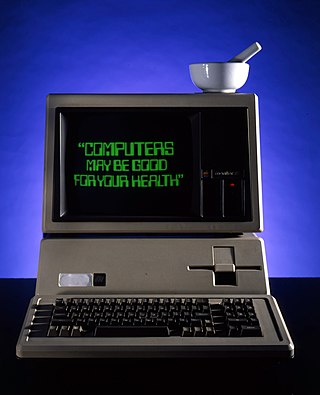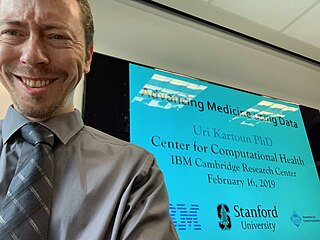Related Research Articles
Information privacy is the relationship between the collection and dissemination of data, technology, the public expectation of privacy, contextual information norms, and the legal and political issues surrounding them. It is also known as data privacy or data protection.

Health informatics is the study and implementation of computer structures and algorithms to improve communication, understanding, and management of medical information. It can be view as branch of engineering and applied science.

The terms medical record, health record and medical chart are used somewhat interchangeably to describe the systematic documentation of a single patient's medical history and care across time within one particular health care provider's jurisdiction. A medical record includes a variety of types of "notes" entered over time by healthcare professionals, recording observations and administration of drugs and therapies, orders for the administration of drugs and therapies, test results, X-rays, reports, etc. The maintenance of complete and accurate medical records is a requirement of health care providers and is generally enforced as a licensing or certification prerequisite.

An electronic health record (EHR) is the systematized collection of patient and population electronically stored health information in a digital format. These records can be shared across different health care settings. Records are shared through network-connected, enterprise-wide information systems or other information networks and exchanges. EHRs may include a range of data, including demographics, medical history, medication and allergies, immunization status, laboratory test results, radiology images, vital signs, personal statistics like age and weight, and billing information.
eHealth describes healthcare services which are supported by digital processes, communication or technology such as electronic prescribing, Telehealth, or Electronic Health Records (EHRs). The use of electronic processes in healthcare dated back to at least the 1990s. Usage of the term varies as it covers not just "Internet medicine" as it was conceived during that time, but also "virtually everything related to computers and medicine". A study in 2005 found 51 unique definitions. Some argue that it is interchangeable with health informatics with a broad definition covering electronic/digital processes in health while others use it in the narrower sense of healthcare practice using the Internet. It can also include health applications and links on mobile phones, referred to as mHealth or m-Health.
A personal health record (PHR) is a health record where health data and other information related to the care of a patient is maintained by the patient. This stands in contrast to the more widely used electronic medical record, which is operated by institutions and contains data entered by clinicians to support insurance claims. The intention of a PHR is to provide a complete and accurate summary of an individual's medical history which is accessible online. The health data on a PHR might include patient-reported outcome data, lab results, and data from devices such as wireless electronic weighing scales or from a smartphone.
Health technology is defined by the World Health Organization as the "application of organized knowledge and skills in the form of devices, medicines, vaccines, procedures, and systems developed to solve a health problem and improve quality of lives". This includes pharmaceuticals, devices, procedures, and organizational systems used in the healthcare industry, as well as computer-supported information systems. In the United States, these technologies involve standardized physical objects, as well as traditional and designed social means and methods to treat or care for patients.
Test data plays a crucial role in software development by providing inputs that are used to verify the correctness, performance, and reliability of software systems. Test data encompasses various types, such as positive and negative scenarios, edge cases, and realistic user scenarios, and it aims to exercise different aspects of the software to uncover bugs and validate its behavior. By designing and executing test cases with appropriate test data, developers can identify and rectify defects, improve the quality of the software, and ensure it meets the specified requirements. Moreover, test data can also be used for regression testing to validate that new code changes or enhancements do not introduce any unintended side effects or break existing functionalities. Overall, the effective utilization of test data in software development significantly contributes to the production of reliable and robust software systems.
Protected health information (PHI) under U.S. law is any information about health status, provision of health care, or payment for health care that is created or collected by a Covered Entity, and can be linked to a specific individual. This is interpreted rather broadly and includes any part of a patient's medical record or payment history.
Biobank ethics refers to the ethics pertaining to all aspects of biobanks. The issues examined in the field of biobank ethics are special cases of clinical research ethics.
Infoveillance is a type of syndromic surveillance that specifically utilizes information found online. The term, along with the term infodemiology, was coined by Gunther Eysenbach to describe research that uses online information to gather information about human behavior.

De-identification is the process used to prevent someone's personal identity from being revealed. For example, data produced during human subject research might be de-identified to preserve the privacy of research participants. Biological data may be de-identified in order to comply with HIPAA regulations that define and stipulate patient privacy laws.

Health information on the Internet refers to all health-related information communicated through or available on the Internet.
Data anonymization is a type of information sanitization whose intent is privacy protection. It is the process of removing personally identifiable information from data sets, so that the people whom the data describe remain anonymous.

Latanya Arvette Sweeney is an American computer scientist. She is the Daniel Paul Professor of the Practice of Government and Technology at the Harvard Kennedy School and in the Harvard Faculty of Arts and Sciences at Harvard University. She is the founder and director of the Public Interest Tech Lab, founded in 2021 with a $3 million grant from the Ford Foundation as well as the Data Privacy Lab. She is the current Faculty Dean in Currier House at Harvard.
k-anonymity is a property possessed by certain anonymized data. The term k-anonymity was first introduced by Pierangela Samarati and Latanya Sweeney in a paper published in 1998, although the concept dates to a 1986 paper by Tore Dalenius.
Data re-identification or de-anonymization is the practice of matching anonymous data with publicly available information, or auxiliary data, in order to discover the person the data belong to. This is a concern because companies with privacy policies, health care providers, and financial institutions may release the data they collect after the data has gone through the de-identification process.

Artificial intelligence in healthcare is a term used to describe the use of machine-learning algorithms and software, or artificial intelligence (AI), to copy human cognition in the analysis, presentation, and understanding of complex medical and health care data, or to exceed human capabilities by providing new ways to diagnose, treat, or prevent disease. Specifically, AI is the ability of computer algorithms to approximate conclusions based solely on input data.

EMRBots are experimental artificially generated electronic medical records (EMRs). The aim of EMRBots is to allow non-commercial entities to use the artificial patient repositories to practice statistical and machine-learning algorithms. Commercial entities can also use the repositories for any purpose, as long as they do not create software products using the repositories.

Merative L.P., formerly IBM Watson Health, is an American medical technology company that provides products and services that help clients facilitate medical research, clinical research, real world evidence, and healthcare services, through the use of artificial intelligence, data analytics, cloud computing, and other advanced information technology. Merative is owned by Francisco Partners, an American private equity firm headquartered in San Francisco, California. In 2022, IBM divested and spun-off their Watson Health division into Merative. As of 2023, it remains a standalone company.
References
- ↑ "Replica Analytics". Replica Analytics. Retrieved 2021-04-02.
- ↑ "Khaled El Emam". www.oreilly.com. Retrieved 2019-11-22.
- ↑ "JMIR AI". JMIR Publications. Retrieved 2021-10-23.
- ↑ "Khaled El Emam". Archived from the original on 2014-01-03. Retrieved 2019-11-22.
- ↑ "Dr. Khaled El Emam - Electronic Health Information Laboratory" . Retrieved 2019-11-22.
- ↑ "Faculty Detail". dtiuottawa. Retrieved 2021-11-11.
- ↑ "Dr. Khaled El Emam". Privacy Analytics. Retrieved 2021-11-11.
- ↑ "Replica Analytics". Replica Analytics. Retrieved 2021-12-12.
- ↑ "Aetion snaps up synthetic real-world data company Replica Analytics". mobihealthnews. Retrieved 2022-01-04.